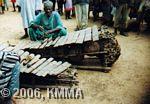




The jengsing is a xylophone with gourd resonators. It has 17 wooden keys suspended over an open framework. The jengsing is played with two wooden sticks, the heads of which are made of rubber. It is traditionally played in pairs in combination with the pendere drum at funerals.
At the end where the bass notes and the largest gourds are, a net is
fitted to protect the gourds.
The cult of the xylophone players, the jeng-duuroo, is led by a
senior man, called the jeng-duuri-haing, who is the headman
of the musicians' cult.
The cult regularly admits new members, who are called gogo-biising
or apprentice musicians. As with most West African cults, the
xylophone-players' shrine, jeng-lurung, is associated with
the players. It is a medicine shrine of the class of non-ancestral shrines
called tomung. These are personal or cult shrines associated with
individual or artisan activities such as blacksmithing, carving or
hunting.
As with carvers and medicine men, the musicians make their instruments from materials they find in their immediate environment. Most materials come from the bush, which give the instrument a magical quality, unlike the fabricated cultural modes of music produced by the jeng-duuroo.
The jengsing is the favoured musical instrument for accompanying dances. The koro for instance is a circular rejoicing dance of the Sissala, danced in an anti-clockwise direction and accompanied by two xylophones and the pendere drum. There is much singing, and one xylophone plays an ostinato figure whilst the other comes in with short rhythmical patterns.
© RMCA/Dominik PHYFFEROEN